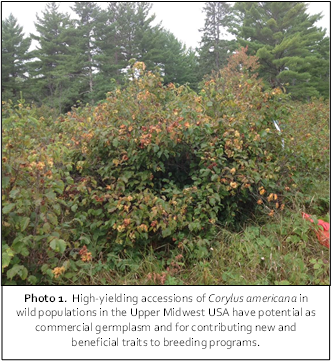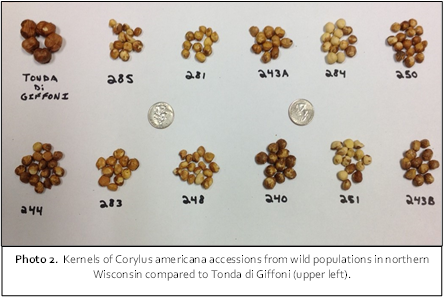Building a Hazelnut Industry Based on Wild-Type American Hazelnut (Corylus americana)

The Upper Midwest Hazelnut Development Initiative (UMHDI) is a research collaboration between the University of Wisconsin, the University of Minnesota, and early-adopter hazelnut growers. The goal of the UMHDI is to develop a commercial hazelnut industry in the Upper Midwest. Although there are currently at least 150 small-scale hazelnut growers in the Upper Midwest, their plantings are not yet commercially viable as they consist of primarily open-pollinated seedlings. In many ways, our work is not unlike the early breeding and industry development work that turned the wild blueberry and low-bush cranberry into the thriving industries we have today.
We are working to develop improved germplasm for the region using two source populations: 1) We are currently screening the on-farm seedling populations of hybrid hazelnuts originating from crosses between American hazelnut and European hazelnut, and anticipate moving select genotypes into farm trial in 2017. 2) We are also screening wild populations of American hazelnut for high-performing individuals for possible release, or more likely for use in controlled crosses.
American hazelnut exists in large populations throughout the Upper Midwest, but particularly on public lands in northern Wisconsin and Minnesota. These populations have never been explored, and, thus, represent significant opportunity for finding new and beneficial traits for winter-hardiness, drought resistance, resistance to Eastern Filbert Blight, resistance to big bud mite and nut weevils, and for new and unique flavors. Since 2010 our team has been screening the wild populations for high performing plants and have selected 50 accessions for propagation and further evaluation. Many of these accessions have demonstrated significant yield potential in the wild (Fischbach et al, 2010). (Photo 1) We have also conducted baseline genetic diversity analysis showing significant within-population diversity (Demchik et al, 2014). Although kernel size is small, some accessions have little to no pellicle, very round kernels, and aroma and flavor profiles that can exceed industry standards such as Tonda di Giffoni (Demchick et al, 2016) (Photo 1). Oleic acid content of American hazelnut is consistently above 75% with some accessions exceeding 80%.

We anticipate the Upper Midwest hazelnut industry to be based on the shrub-type American hazelnut with over-the-row harvesting as is done with blueberries. Initial cultivars of hybrid hazelnuts selected from the on-farm populations will be followed in the years to come by clonal material of pure American hazelnut or backcross offspring from crosses between European hazelnut and our American hazelnut selections. More about the UMHDI and our work with American hazelnut can be found at www.midwesthazelnuts.org or by emailing jason.fischbach@ces.uwex.edu or michael.demchik@uwsp.edu
References:
Demchik MD, J. Fischbach, A. Kern, J. Lane, B. McCown, E. Zeldin, and K. Turnquist. 2014. Selection of American hazelnut as a potential oilseed crop. Agrofor. Syst. 88:449-459.
Demchik, M.D., J. Fischbach, and M.D. Yates. 2016 (in press). Physical characteristics and sensory analysis of American hazelnuts in comparison to Tonda di Giffoni. Agrofor. Syst.
Fischbach J, M. Demchik, and K. Brasseur. 2010. Screening wild populations of American hazelnut in NW Wisconsin for high yielding plants. Bayfield County UW-Extension Research Bulletin #16, Washburn, WI http://midwesthazelnuts.org/assets/files/Research%20Bulletin%2016_American%20hazelnut%20yields.pdf
This article was posted in WFN, Vol. 1-4 and tagged Corylus americana, hazelnut, Jason Fischbach, wild-type American hazelnut.
